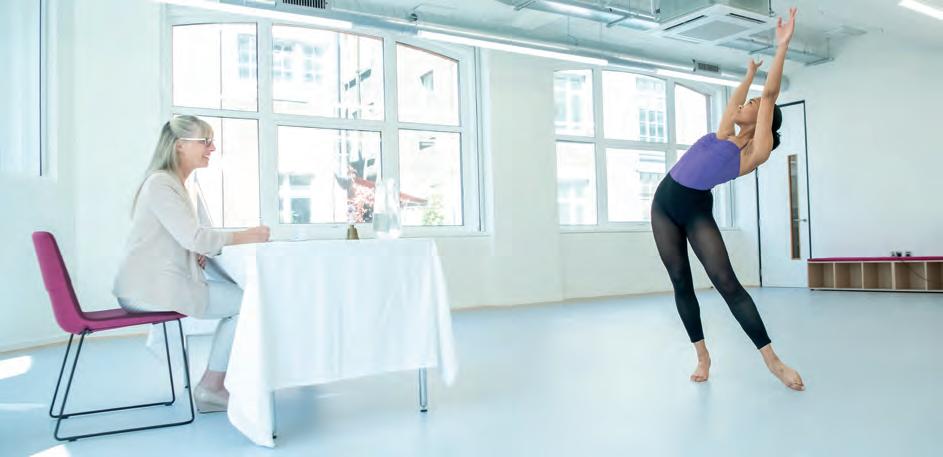
5 minute read
Capturing the dance
A comprehensive guide to filming dance performances.
In today’s dynamic world of dance education, recorded dance performances have become an invaluable tool for evaluating and showcasing students’ talents. As dance educators, mastering the art of filming can help to identify areas where our students can improve their technique and performance skills. This guide will provide you with an overview of the entire process, from equipment selection to recording guidance, empowering both you and your students to navigate these techniques with confidence.
Getting the right equipment
Before hitting the record button, having the right equipment is essential. While professional cameras can yield stunning results, creating high-quality dance videos doesn’t need to break the bank. Here’s what you need:
• Camera: A good smartphone with a high-resolution camera can suffice on a budget. However, if you have access to a dedicated video camera, it may offer more control over settings such as light exposure, focus and frame rate. (Frame rate is the number of individual images (frames) captured by a camera during one second of video.)
• Tripod: Ensure camera stability by using a tripod, which eliminates shaky footage and provides a professional look. You may also wish to consider weighting it down so that it remains secure during even the most vigorous routine.
• External microphone: The built-in microphones found in video cameras can be sufficient, however it may not always be ideal. An external microphone will allow you to experiment with placement to capture a better representation of the sound in the space.
• Lighting: Well-lit studios are vital. Position direct light sources behind the camera to prevent shadows and accentuate dancers. It may be prudent to invest in additional lighting equipment if necessary.
• Storage and batteries: Make sure you have sufficient storage space for the recording you plan to make, and if you are unable to use mains power, that the battery is fully charged.
Planning and preparation
Success in filming dance performances starts long before the dancers take to the stage. Planning and preparation are crucial to achieving the desired outcome.
• Consent to film: Obtain informed consent from parents, guardians, or carers of participating students. Ensuring you have proper consent is not only a legal requirement but also demonstrates respect for the privacy and wishes of your students and their families.
• Clothing choice: For clear visibility against dark backgrounds, dancers should wear light-coloured clothing, and vice versa.
• Dance area setup: Place markers (such as beanbags or PVC tape) to map out the dance area to ensure students always stay in the frame.
• Setting up equipment: Choose a location for your camera, tripod, and lighting that provides an unobstructed view of the entire dance area.
• Recording orientation: Position your device to film in landscape orientation. This will capture a wider horizontal view, aligning with the natural width of human vision and providing a more context-rich perspective for dance performances.

• Facial expressions: Ensure the learner’s facial expressions will be visible. If the learner is too distant, subtle expressive skills may be difficult to see.
• Audio: Place music speakers/accompanists a distance away from the microphone or recording device to prevent sound distortion. As dance studios tend to be very reverberant spaces, the clarity of spoken introductions can be improved by marking out a dedicated spot close to the camera to stand while talking.
• Camera settings: Experiment with camera settings well in advance. Set it to record in MOV or MP4 format, in at least 720p HD quality, and disable auto-focus to prevent sudden re-adjustments during a performance.
• Test footage: Perform test shots to verify that your equipment is functioning correctly and that the lighting is adequate. This is also an excellent opportunity to check your microphone’s audio quality.
Capturing the performance
Now that you’ve prepared your equipment and environment let’s investigate some of the things you will need to keep in mind when filming a dance performance:
• Minimise noise: Keep extraneous noise to a minimum to ensure clear audio and undisturbed learner performances.
• Using a camera operator: If employing a camera operator, ensure they are familiar with the performance and can maintain the learner at the centre of the shot.
• Extended filming: Press record well before the start of the performance and continue recording for several seconds once it has finished.
• Review the footage: As soon as the recording is complete, review the footage to ensure the picture and audio has recorded as expected. If there have been any technical issues, another take can be attempted while everyone is still present.
Filming dance performance is a skill that anyone can master with practice. By investing in the right equipment and with careful planning, you can create captivating videos that both celebrate the artistry of your students and are an invaluable teaching aid to help your students succeed whilst celebrating the beauty of dance in this digital age.
Membership +
Prepare for your upcoming remote examinations with precision and ease!
Discover comprehensive instructions for filming by logging into the My ISTD section of our website. Simply head to: www.istd.org/my-istd/examination-information/remote-examination-scripts
Uncover the keys to successful remote examination filming, thoughtfully presented with instruction films and a guidance document for your convenience and accessibility.






